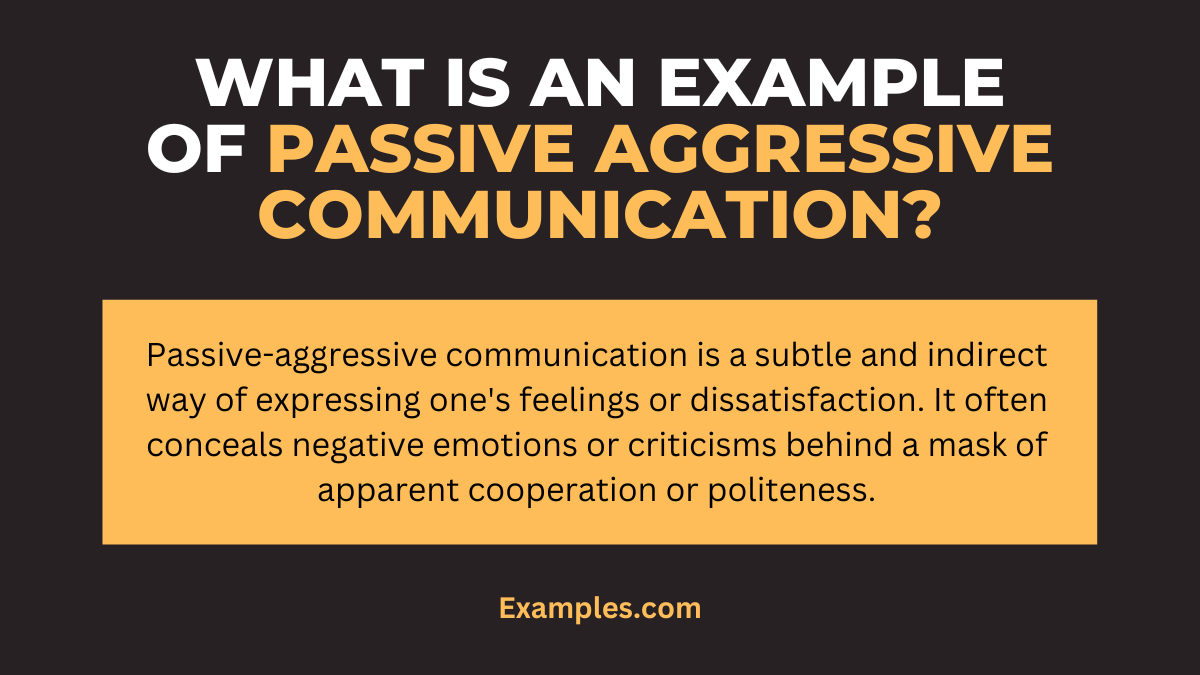How to Communicate with a Passive Aggressive Person?
Unlock the Art of Communication with Passive Aggressive Individuals – A Definitive Guide with Practical Examples delves into the intricate world of engaging with passive aggressive personalities. This comprehensive guide is enriched with real-world scenarios, demonstrating effective strategies for recognizing subtle cues and responding appropriately. Discover how empathetic listening and clear expression can transform challenging interactions, fostering a more positive and productive dialogue. This guide is an invaluable resource for anyone seeking to navigate the complex dynamics of communicating with passive aggressive individuals, be it in personal relationships or professional settings.
What is an Example of Passive Aggressive Communication?

Passive-aggressive communication is a subtle and indirect way of expressing one’s feelings or dissatisfaction. It often conceals negative emotions or criticisms behind a mask of apparent cooperation or politeness. An example of passive-aggressive communication is when someone agrees to a task or request but deliberately procrastinates or does it poorly, hoping to indirectly convey their resentment or disapproval.
In this scenario, the individual may agree reluctantly to complete a task but then deliberately delays it, making it evident that they are unhappy without openly addressing their concerns. Passive-aggressive communication can be frustrating and confusing, as the true feelings and intentions are often hidden behind a facade of compliance.
How to Communicate with a Passive Aggressive Person?

Effective communication with a passive-aggressive person requires a nuanced and deliberate approach. Here’s an expanded view of the strategies outlined:
- Maintain Calmness: Keeping calm is crucial. Reacting with frustration or anger can worsen the situation. A calm demeanor can defuse tension and set a constructive tone for the conversation.
- Use Direct Communication: Clear and direct communication is key. By speaking plainly and avoiding ambiguity, you can counter the indirect nature of passive-aggressive communication, encouraging more straightforward interactions.
- Empathy is Key: Demonstrating empathy and understanding towards their feelings can help break down barriers. Acknowledging their perspective validates their emotions and can open the door to more genuine communication.
- Set Clear Boundaries: Clearly articulate your boundaries and the consequences of crossing them. This clarity helps passive-aggressive individuals understand the limits and expectations in the relationship.
- Avoid Confrontation: Address issues in a non-confrontational, constructive manner. This approach can prevent the escalation of conflict and encourage a more open dialogue.
- Encourage Openness: Foster an environment where the passive-aggressive person feels safe to express their thoughts and feelings openly. This can reduce their reliance on indirect methods of communication.
- Be Assertive: Communicate your needs and stand your ground in a respectful manner. Assertiveness, as opposed to aggression, ensures your voice is heard without overpowering the other person.
- Focus on Problem-Solving: Redirect conversations from personal grievances to collaborative problem-solving. This shift in focus can lead to more productive outcomes.
- Seek Professional Advice: In particularly challenging situations, don’t hesitate to involve a mediator or counselor. A third-party perspective can provide new insights and facilitate healthier communication.
- Model Positive Behavior: Demonstrate healthy communication practices. Leading by example can influence the passive-aggressive person to adopt similar communication strategies over time.
Employing these tactics can improve communication with a passive-aggressive individual, fostering a more open, respectful, and productive dialogue.
Examples for How to Communicate with a Passive Aggressive Person
Effectively communicating with a passive-aggressive person involves a blend of directness, empathy, and assertiveness. It’s crucial to remain calm and composed, addressing issues in a straightforward yet non-confrontational manner. Demonstrating understanding and empathy can help in breaking down communication barriers. Setting clear boundaries and consistently enforcing them is key. Focusing on problem-solving rather than dwelling on grievances leads to more productive interactions. Encouraging open dialogue and leading by example with healthy communication practices can gradually influence positive changes in their communication style.
- “I’ve noticed you’re often quiet in meetings. Is there something you’d like to add?” – Encourages open communication in a non-threatening way.
- “When you said ‘whatever,’ it seemed like you might have more to say. Can we discuss this?” – Addresses indirect communication directly.
- “I feel there might be an underlying issue here. Would you like to talk about it?” – Invites honest conversation about hidden grievances.
- “Your report was late, which impacted the team. Let’s work on a solution together.” – Directly addresses an issue while focusing on collaborative problem-solving.
- “It’s important to me that we communicate openly. How can we improve our discussions?” – Promotes open dialogue and seeks mutual improvement.
- “I sense some hesitation in your response. Do you have concerns about the project?” – Acknowledges non-verbal cues and seeks clarity.
- “I value your input. Let’s set a time to go over your ideas in detail.” – Shows appreciation and encourages direct input.
- “Your recent emails have been vague. Can we clarify your points for better understanding?” – Requests clarity in written communication.
- “It seems like you’re not comfortable with the decision. What are your thoughts?” – Encourages sharing of thoughts and feelings.
- “I notice you often agree but seem unsatisfied. Let’s discuss any reservations you have.” – Addresses passive agreement and invites honest feedback.
How to Deal with Passive Aggressive Coworkers?
Dealing with passive aggressive coworkers effectively involves a combination of empathy, assertiveness, and strategic communication:
- Recognize the Behavior: Understand the signs of passive aggression, like indirect communication or non-compliance.
- Respond Calmly: Maintain a calm demeanor. Reacting emotionally can escalate the situation.
- Communicate Directly: Address issues directly yet tactfully. Avoid being confrontational but be clear in your communication.
- Use ‘I’ Statements: Frame your concerns from your perspective to avoid accusatory language.
- Set Boundaries: Clearly define your boundaries and the consequences of crossing them.
- Encourage Open Dialogue: Foster an environment where open and honest communication is valued.
- Focus on Solutions: Shift the focus from personal grievances to finding practical solutions.
- Seek Support: If necessary, involve a supervisor or HR for mediation.
- Lead by Example: Demonstrate positive communication behaviors.
- Document Interactions: Keep a record of interactions in case the behavior escalates or needs to be addressed formally.
Dealing with passive-aggressive coworkers requires patience and a thoughtful approach, aiming to foster a more open and positive work environment.
Examples for How to Deal with Passive Aggressive Coworkers
Dealing with passive-aggressive coworkers can be a delicate balance, but effective communication is key. Here’s how to navigate this challenge:
- Address the Behavior: Gently confront the passive-aggressive behavior by using “I” statements to express your feelings without blaming.
- Active Listening: Show empathy by actively listening to their concerns and validating their feelings, promoting a more open dialogue.
- Clarify Expectations: Clearly communicate your expectations and responsibilities to minimize misunderstandings and passive-aggressive responses.
- Stay Solution-Oriented: Focus on finding solutions to problems rather than dwelling on the passive-aggressive behavior itself.
- Offer Feedback: Provide constructive feedback when necessary, using specific examples to illustrate the impact of their behavior.
By implementing these strategies, you can effectively address passive-aggressive behavior and maintain a more productive and harmonious work environment.
In conclusion, effectively communicating with a passive-aggressive person requires patience and empathy. By utilizing clear and assertive communication while acknowledging their feelings, you can foster understanding and promote healthier interactions. Remember that addressing passive-aggressive behavior with sensitivity can lead to improved relationships and more constructive dialogues.



